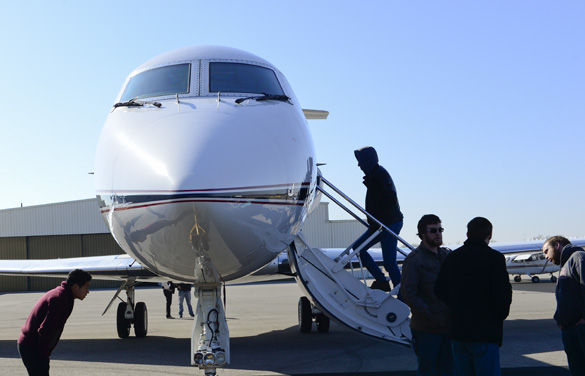‘Chrysler’ of jets comes to SIU

February 3, 2015
After serving the U.S. Navy for decades, a Gulfstream III jet will be serving the students of SIU’s aviation program.
Michael Burgener, chairman of the Department of Aviation Technologies, said the Navy donated the jet, which he said is in great condition, after it was decommissioned Tuesday.
“Gulfstream is one of the premier manufacturers of business jets in the country,” he said. “We’re going to use it for a majority of our classes for maintenance training and for avionics training.”
Advertisement
The Gulfstream III, which is more than 80 feet long with a 78-foot wingspan, will be the second largest aircraft the department has. The only aircraft owned by SIU larger than it is the 1960s Boeing 737 the university received in 1998, Burgener said.
Burgener said the Department of Defense put more than $1 million in renovations into the jet, which was built in 1983. The Gulfstream is also the newest in SIU’s fleet and uses aviation electronics, or avionics.
“Avionics is a field of technician that deals more with the instruments, with the autopilot, the navigation system, the communication systems, the radios, flight management systems,” he said. “This aircraft has a lot of that. It has capabilities that no other aircraft in our program has.”
Burgener said another one of the best aspects of the jet, which cost approximately $30 million when new, is that students will be working on the same kind of jet as many professionals.
“There’s several large maintenance repair organizations in the state of Illinois that have large contracts with Gulfstream to maintain the jets,” he said. “Many of our students go to work for these companies after graduation.”
From classes on hydraulics to classes on computer systems, Burgener said the jet can be a tool for learning how to maintain nearly all aspects of similar airliners.
Wilson Meador, a senior studying aviation technology, said students will learn the ins and outs of the machine as well as how to diagnose problems. Meador said they will run tests on the jet, putting it in different situations, making aspects like tire pressure deplete, and then consider how to fix it.
Advertisement*
Burgener said this is one of the biggest aspects of aviation technology.
“We train students to be able to maintain aircrafts as technicians, so they have to learn all the systems on the aircraft,” he said. “That’s what it’s going to be used for. The only thing we’re not going to do is fly it.”
Burgener said to fly the plane, the department would have to pay to get it reclassified from a military aircraft to a civilian one. He said the university has no plans to do so, citing fuel costs for the high-powered jet as another reason for it to remain grounded.
Michael Higgs, a senior from Central City, Ky., studying aviation technology, said working on a plane with a functioning turbine, as opposed to a propeller-powered plane, is something he looks forward to.
“Most of our turbines we get to work on don’t run anymore so it’s exciting to get to play with something new like this,” he said.
Other students were excited about different aspects of the university’s latest addition.
Zach Swint, a junior from Rolling Meadows studying aviation technology, said the modernity of the Gulfstream includes a more digital display that uses fewer gauges.
“Avionics system is all computers rather than all steam, which is what older aircrafts use,” he said.
Alec Tepps, a junior from Lindenhurst studying aviation technology, said even though the jet is older than he is, the technology is still pretty modern.
“It’s definitely nice to have something that’s coming right off the workforce,” he said. “Everything’s in great condition.”
Tepps said the technology in aviation is always being updated and even his professors have to take classes to keep up with the machinery. Although the Gulfstream is far from the most modern jet in existence, he said it will still help students immensely.
He said many of today’s planes and jets are nearly capable of being flown completely on auto-pilot and this jet will put the students closer to learning that technology.
As for the future of the jet, Burgener said he intends to keep the Gulfstream in mint condition for a long time.
“It will last longer [than the Boeing],” he said. “The Boeing we have to leave outside because of the size of it. With the Gulfstream, we’re going to put it inside. It’ll stay nice.”
Advertisement







